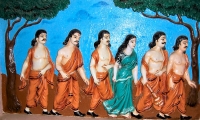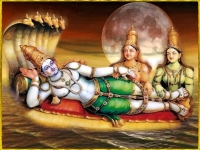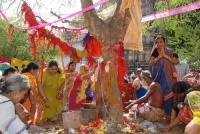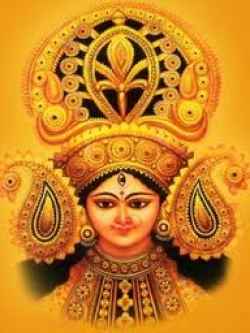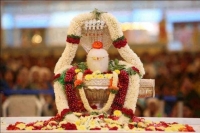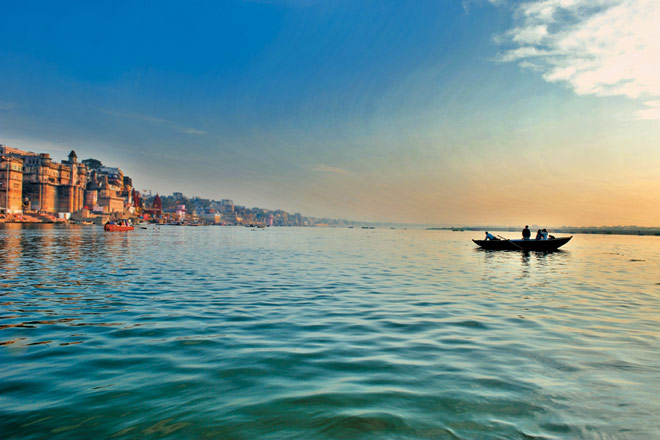
In Hindu mythology, the revered Ganges has extreme significance. From the mythological point of view, this sacred river is known as Goddess Ganga.
The followers of the Hindu religion also call it as "Mother Ganges". Locally, they use the term "Ganga Maa" to refer to the sacred river. The river Ganga is adored as a "Goddess".
Ganga is one of the most popular rivers in the world. The river is also very famous for its unequal length and width all over the globe.
In Purans, it is mentioned that not only the touch even the name of the river purifies the souls of the Hindus.
The water of the sacred river Ganga is known as "Ganga Jal". This water is considered as the most pure water on the earth.
River Ganga came into existence from Gaumukha, sited in the state of Uttaranchal. The site also has rich popularity among the worshippers in India.
The source of the Ganga River flows touching the various pilgrimage destination like Kedarnathji, Haridwar, Allahabad and Varanasi.
Ganga is shown as a beautiful woman representing half of the body of a fish in stead of legs and half of the woman. Ganga use to ride on the water monster named Makara.
Ganga is illustrated in many Hindu scriptures as Purans, Ramayana, Mahabharata and Rig-Veda. The birth of Ganga is distinctively described in Hindu scriptures.
During the self-abasement of Jahnu he drank the whole water and ordered her to come out of his ears. Mahabharata depicts Ganges as wife of Shantanu and Mother of Bheesma.
The story of Gangavataranam :
According to the legends and Puranas, goddess Ganga used to flow in the heavens. It was brought to the earth by the penances of a sage named Bhagiratha.
He vowed to rescue his ancestors who were stuck in the underworld. The sage was originally a king of Kosala and a descendent of king Sagara (meaning ocean).
It said that once Sagara performed a horse sacrifice to conquer new territories and as part of the sacrifice set the sacrificial horse free.
According to the tradition, wherever the horse went that territory would be annexed to the kingdom, unless he was challenged by a rival king and defeated.
As soon as it was set free, the horse galloped away into the open lands, followed by king’s men. After sometime, it disappeared. King’s men searched for it, but it was not found. They went back and reported to the king. Upon knowing the news, king Sagara deputed his 60,000 sons to find the horse and bring it back. Those sons were born to him through his wife and queen, Sumati.
His sons dutifully searched all the places for the horse. For a long time, they could not find it anywhere. At last, one day they found it in the Ashram of a sage named Kapila. They saw that the horse was tied to a pole, and nearby the sage was in deep meditation. Seeing the horse in that condition, without ascertaining facts, they assumed that the sage might have stolen the horse. Without thinking about the consequences, and lacking discretion, they attacked the sage while he was still in meditation.
Disturbed by their actions, the sage opened his eyes and saw the sons of Sagara in a warring mood, with their weapons drawn. Because of the austerities and penances, the sage was brimming with immense spiritual power (tapah). So intense was the tapasic power, which radiated from his eyes, Sagara’s sons had no chance of escape. As soon as his gaze fell upon them, they were instantly burned by the heat that emanated from his eyes and turned them into ashes.
The sage sensed what happened and felt remorse. He conveyed the news to Sagara and suggested that his sons could be revived if the waters of Ganga flowed over their ashes and purified them. Since the river flowed in the heaven only, someone had to make an austere effort to bring her to the earth. For a long time, none of the descendants of Sagara could accomplish the task. The souls of their ancestors remained stuck in the underworld, with no one coming to their rescue. As time passed, the kingdom of Kosala also fell into bad times and lost its former glory. By the time Bhagiratha was born, it was in ruins.
Upon knowing what happened, Bhagiratha decided to rescue his ancestors and a resolve a problem that had been haunting his family for generations. He undertook a great penance to seek the help of gods and persuade the goddess Ganga to flow upon earth. For a thousand years, he performed austerities. In the end Brahma appeared before him and suggested that he should propitiate Shiva, who alone was capable of solving his problem. Then, Bhagiratha meditated upon Shiva for a year. Pleased by his sincerity and resolve Shiva appeared before him and promised to help him.
He summoned the gods and requested them to persuade the goddess to turn earthward. Initially, she was reluctant as she was unsure whether the earth could bear the intensity of her spiritual power. She felt that earth was not yet ready for her descent. Shiva then intervened and suggested that he would act as the intermediary. It would be safe, if the river first descended upon his head where he would absorb much of the force and let her flow from there to the earth with diminished capacity.
As the sister of Parvathi, Ganga had great respect and admiration for Shiva from her childhood. She even dreamt of marrying him, but it did to happen as Shiva married her elder sister. She felt that it was a great opportunity to become associated with him and enjoy his company. Therefore, she readily agreed to his suggestion and landed upon his head with great force of love.
The force was so powerful that as soon as she landed upon his head, her flow broke into seven sub streams, which became tributaries. Three of them flowed to west and three to east. The remaining seventh one, which goes today by the name Ganga, followed Bhagiratha to the place where the ashes of his ancestors lay. As she flowed over them, they instantly achieved liberation.
Ever since, Ganga acquired a great significance as a sacred river. Since she flows from the head of Shiva, her waters can wash away all impurities, including past sins. She also came to be recognized as a consort of Shiva and an integral part of the Shaiva pantheon.
Because he bears her upon his head, Shiva also earned the epithet of Gangadhar or Gangadhaari, meaning the bearer of the River Ganga.
Overtime, Ganga became an important cultural symbol of Hinduism and an integral part of the Vedic rituals and folklore. Numerous cities sprung upon its banks. It witnessed the flowering of a great civilization and the birth of several great seers, saints and founders of religions and religious sects. It figures prominently in the Puranas and the epics.
Many famous kings, spiritual masters, and even the Buddha and Mahavira wandered on its banks and shared their wisdom. The childhood of Rama and Krishna passed on its banks and in its vicinity. They all drank from its waters and made it even more sacred.
Ganga sanctified the land of the Vedas and made it sacred. Over the centuries, she washed away the sins of countless people and granted them liberation. Even now, people to take a dip in the river to cleanse their sins and find solace from their past karma. Many immerse the ashes of deceased relatives in the river or cremated their bodies on its banks, hoping that it will help them attain liberation.
Symbolic Significance of Gangavataranam :
The story of the descent of Ganga (Gangavataranam) has a great symbolic significance in Hinduism. Symbolically, it represents the following.
The descent of Shakti or Mother goddess (Ganga) into the mind and body (earth) and the liberation of the embodied soul from the sins of the past.
The flow of divine knowledge, or the knowledge of liberation (Ganga), into human consciousness (earth) by the grace of God (Shiva) and the austere efforts of enlightened masters (Bhagiratha).
Transmission of the sacred knowledge of the Tantras, by Shiva to Parvathi.
The duty of a householder (Bhagiratha) towards his ancestors (Sagara’s sons).
The falling of the rain water from the sky, which eventually becomes a nourishing and life-giving stream or river.
Spiritual instruction by an enlightened teacher (Shiva) to a student (the mortal world).
The descent of the soul from the ancestral heaven at the time of rebirth through the rains first into the male body (Shiva) and later into the female body (the earth).

